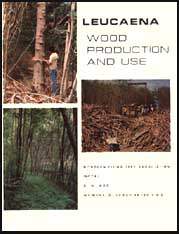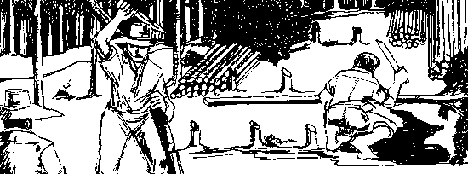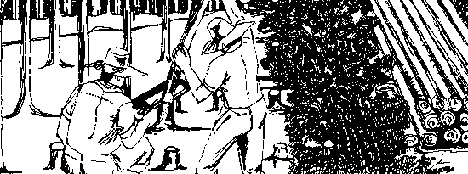Harvest age is dependent on site quality and the type of end product desired. There is no fixed rotation age for the harvest of wood from leucaena. The tree is harvestable for small poles in one year on good sites, and appears to continue height growth for 5 years and diameter growth for 10 or more years thereafter. Spacing affects both diameter and height development, and may be used as an effective management tool to alter rotation age as desired (see Section 5-6).
Site quality directly affects rotation age. Efforts to predict rotation age should consider soil pH, soil depth and fertility, rainfall, wind stress and other factors. Poor sites can extend the rotation age by many years, notably when rainfall is limiting, temperatures are low, or soils are deficient in one or more important nutrients. Leucaena should not be planted on poor sites for production of large poles or pulpwood.
Four years appears to be a suitable rotation age for fuelwood use of leucaena in large plantations on most sites. Trees planted at 1 x 1m spacing maximize yields, show good form, and are of manageable size for manual harvesting and extraction in four years (Figure 7-1). Rotation cycles may be decreased following first coppicing, as regrowth is rapid.
7-2 WOOD YIELD
Reported wood yields of leucaena are based primarily on experimental plantings and small plantations, and range from 7 to 77 m³/ha/yr. In general yields below 15 m³/ha/yr are considered poor, indicating lack of adaptability, soil fertility or management. Yields above 30 m³/ha/yr are very good, indicating good sites and management.
Unusually low yields have been reported (less than 1 m³/ha/yr) in regions of Taiwan with low soil pH and cool temperatures. Exceptionally high yields exceeding 130 m³/ha/yr) have been reported, but should be taken with great caution until experimental and mensurational techniques have been verified.
Yield increments of 90 sample plots in 20 Philippine dendrothermal plantations (avg. age = 2.5 years) ranged from 0.25 to 47.0 t/ha/yr. This range is a reflection of a variety of sites, ages and management practices. Yield increments of the best 10 plantations ranged from 13 to 32 t/ha/yr.
As these observations make clear, leucaena plantations must be established on good sites to attain high growth rates without soil amendments. Fertilizer applications improve leucaena yields on poor quality sites, just as they do for major farm crops, and must be considered long-term investments necessary to obtain maximum yields on poor quality sites. In many cases, yields will be greater for coppice regrowth, where weed competition no longer exists' and existing root systems are well established.
7-3 MANUAL HARVEST
Leucaena is ideally suited to manual harvesting operations, as trees are not usually grown so large that two men cannot easily handle stems. Studies in Hawaii and field operations in the Philippines indicate that about 70 man-days/ha are required for manual felling at 10,000 stems/ha. Care must be taken to fell trees correctly, leaving sound, healthy stumps. Excessive damage to remaining trees should be lessened by controlling the direction of fall to avoid branch and stem breakage.
Tools used in harvesting include machetes, axes, and saws of various types. The most efficient and cost-effective tool is probably the hand or bow saw. Hacking a tree with axe or machete shatters the wood and invites disease infection. Infected stumps can be killed by fungal attacks, and coppice regrowth greatly reduced. The saw should be used to cut the stems at a slight angle to allow for water drainage. Optimum cutting height is 1025 cm. Larger stumps leave much wood behind and produce coppice shoots more susceptible to wind damage.
Harvesting can be done by 1- or 2- man teams. A two man team is perhaps most effective when one man holds the stem, directs its fall and assists the second man who saws. Trees should be directed while falling so that the butt end faces the direction of haul. Slash is best piled in alternate rows, leaving clear lanes for hauling trees out of the plantation. On larger stems, more skill is needed. An undercut must first be made in the intended direction of fall, followed by an overcut made in the opposite side of the stem.
Figure 7-2 Manual harvesting techniques in a closely spaced plantation:
MACHETE HARVESTING - Trees are felled by bending stem and striking cleanly. Felled stems are forwarded to assistant for delimbing and pruning. Suitable for small diameter stems.
SAW HARVESTING - Two-man teams fell larger diameter stems with bow saw. Operation is facilitated by assistant bending the tree while the saw cut is made. Cut stems are forwarded to delimbers. Slash and wood are piled in alternate rows.
CHAINSAW HARVESTING - Economic for largest diameter stems. Fellers and assistants work together down a row, the assistant pushing felled stems so the butt faces the direction of haul. Machete teams follow to prune, buck, and forward felled trees.
Trees might be left in the field for several days while the leaves fall off and the wood begins to dry. Transport must be arranged in a way which does not damage stumps and allows for efficient extraction of the wood.
7-4 MECHANICAL HARVEST
No major plantation experience exists with mechanical harvesting of leucaena. Two mechanical harvesting system alternatives have been proposed for use in Hawaii in the production of wood chips for fuel. These are briefly reviewed below:
- Feller bunchers, grapple skidders, roadside chipper. This system involves major equipment investments with skilled operators and is not economically feasible with large numbers of small diameter trees.
- Swath-felling mobile chipper. Self-propelled, in-field chippers are able to fell trees and chip them directly. This system is capital-intensive, but has low labor requirements.
7-5 COPPICE MANAGEMENT
The management of leucaena during and after coppicing is perhaps the least understood area of plantation operations. Experimentation with cutting tools, heights of cutting, and pruning of coppice shoots is encouraged on all large plantations. A 10-15 cm stump height is probably best for coppice regrowth and root expansion, however evidence from trial plantings suggest that higher stumps produce fewer dominant shoots and may promote natural pruning. Thinning of shoots may or may not be necessary, depending on the density of the plantation, and the type of end product desired. In an irregular stand with high between-tree variability, it may be desirable to kill small or diseased stumps with diesel oil and allow larger, healthier stump to grow, retaining more coppice shoots per stump to compensate.
In Hawaii, 4-year-old trees pruned naturally to 1.5 stems per stump (avg.) after a chainsaw felling. Spacing was 1.5 x 1.5m, with a stump height of 1m. Shoot thinning has been necessary in Taiwan, however, to obtain this number of shoots. Harvesting of closely spaced plantations in the Philippines has resulted in a high degree of sprouting, and thinning shoots in these plantations may be necessary. The number of shoots is obviously affected by the season and growth conditions, but will generally be higher rather than lower than desired.



